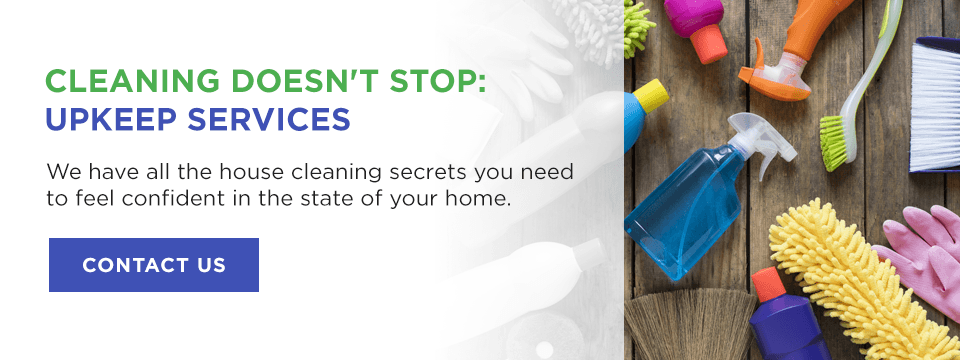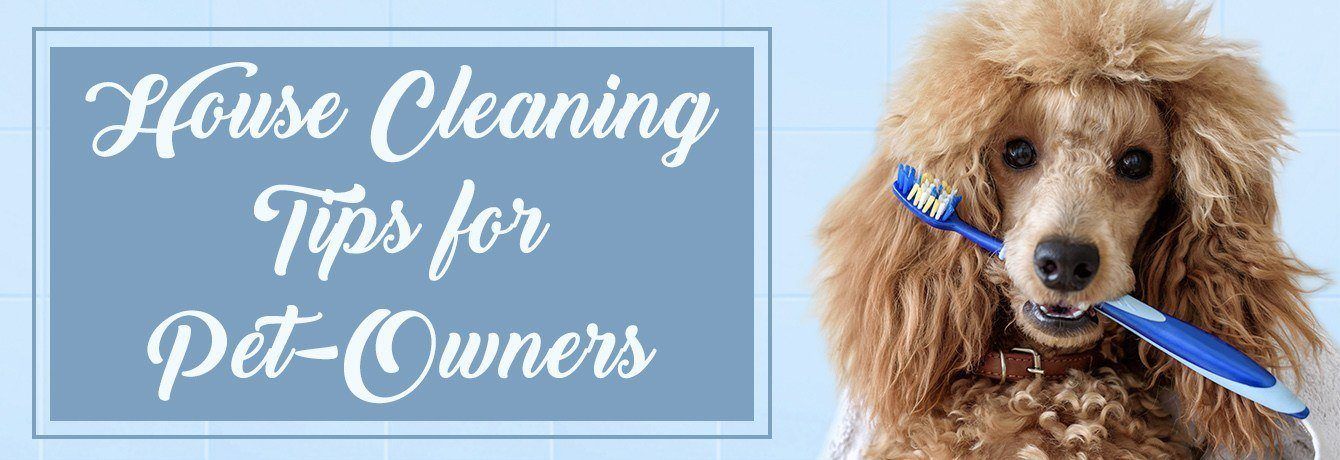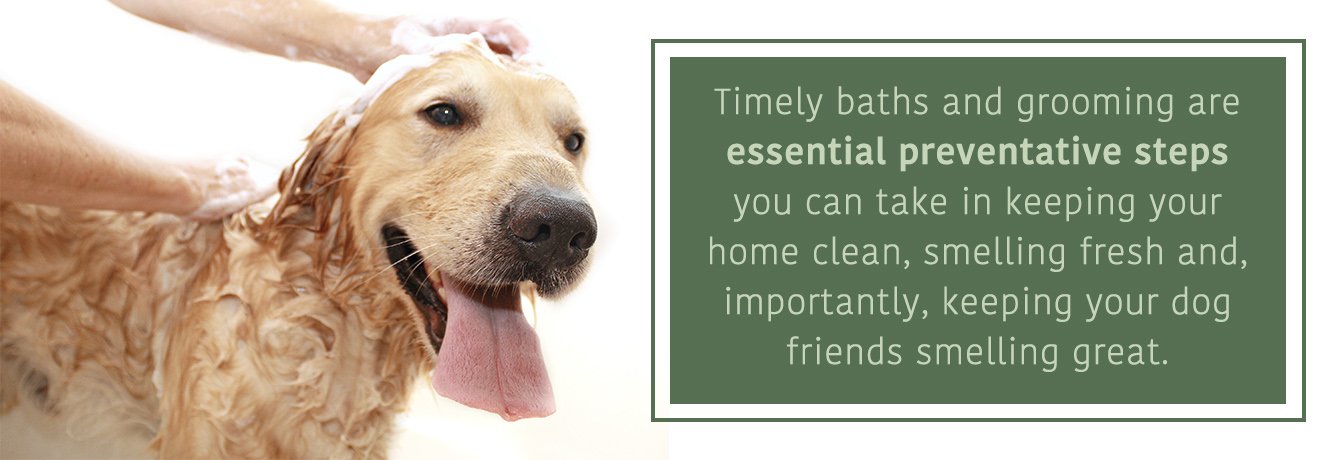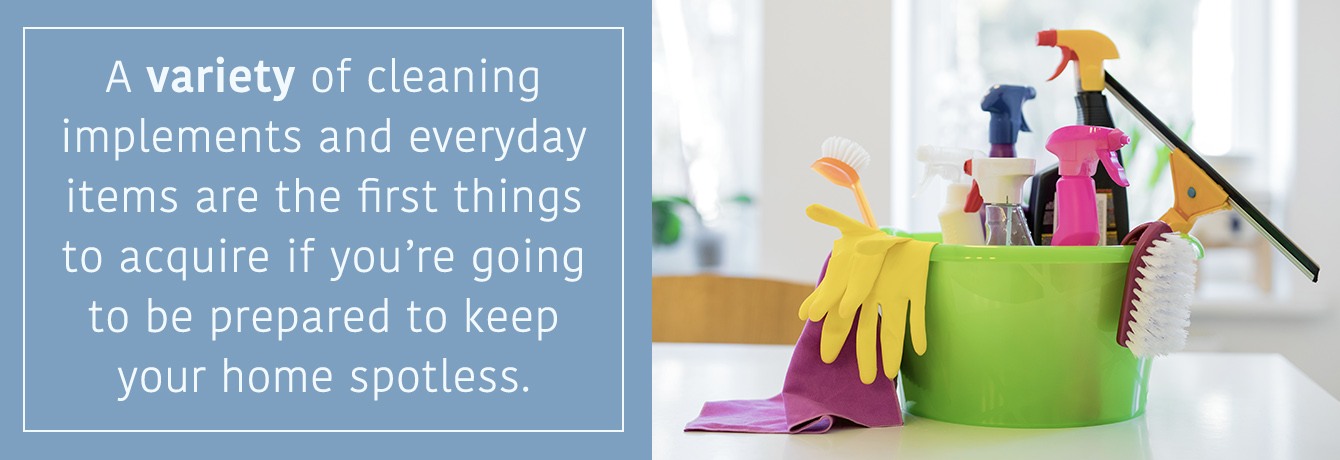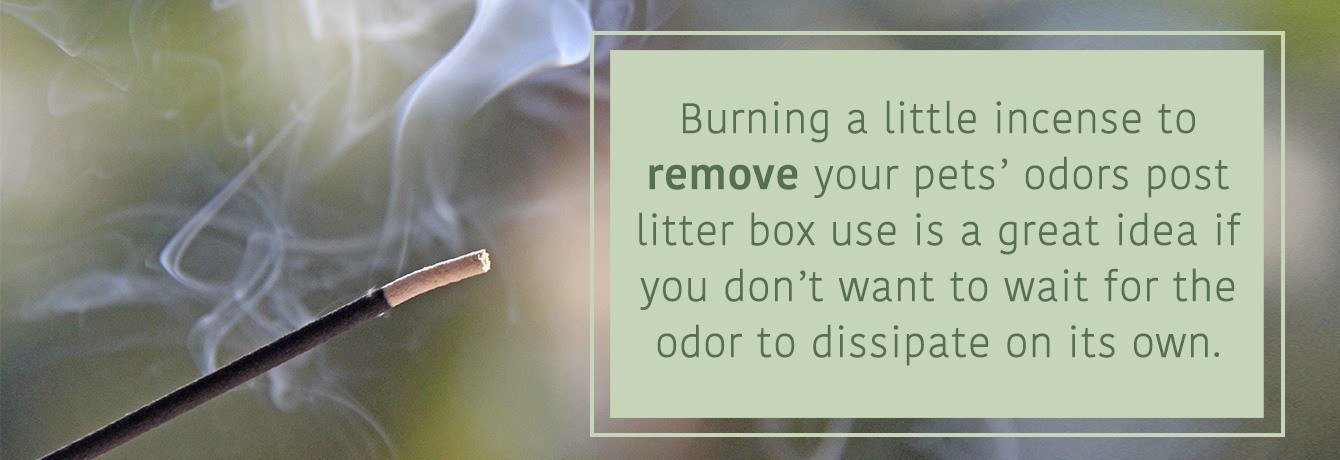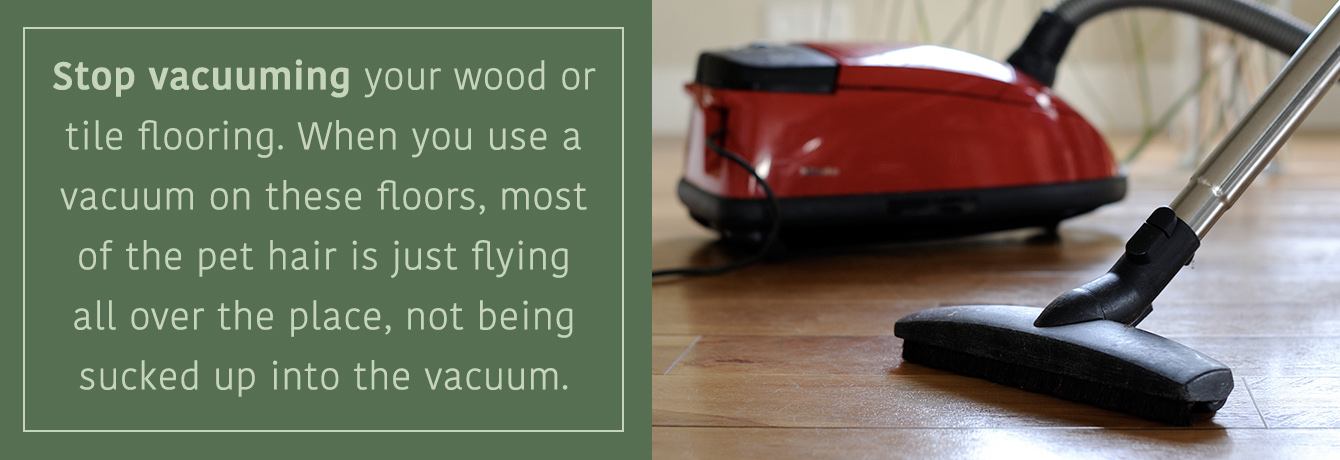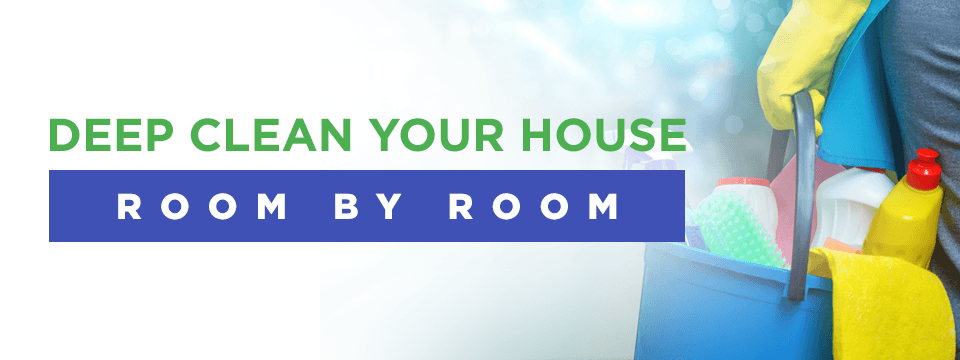
Your home is where the heart is — and as the setting for your family dinners, lazy Sunday mornings, busy weeknights and special moments spent together, your heart is your house. While renting or owning a house brings its own brand of joy, it also comes with a bundle of responsibilities — from balancing the bills and money management to more physical home needs like maintenance, repair and, most importantly, cleaning. When you’re busy packing lunches, cooking dinners and keeping up with the kids’ schedules while juggling your work life every day, sometimes those little cleaning and upkeep tasks can slip through the cracks and start to pile up, leaving you with a less-than-clean abode by the time you catch your breath and have time to look around.
Even when you do your best to clean up, spot clean and stay on top of regular house cleaning tasks, a house is a big place that sees a lot of activity. It’s only natural for it to accumulate layers of dust and dirt, streaks and stains over time — that’s why every home needs a deep cleaning now and then. Also known as the classic household “spring cleaning,” a deep cleaning means an in-depth, thorough cleaning of the entire house that covers every room and can include areas like windows, walls, floors, furniture and surfaces. If you’re thinking of deep cleaning your house, you’re not alone — while 74 percent of Americans perform “light cleanings” regularly, 91 percent of the population participates in spring cleaning, with 76 percent repeating the process each year.
As the place where you live with your family and share so much love, your house deserves a little love, too, and thorough cleaning is just the right way to refresh both your surroundings and yourself. But how do you deep clean a house? Where should you begin, what should you cover and how long will it take? If you’re looking for tips for a home deep cleaning, we’re here to help. From deep cleaning house hacks to how to clean every room of the home, here’s your deep cleaning house checklist.
When Cleaning a House, Where Do You Start?
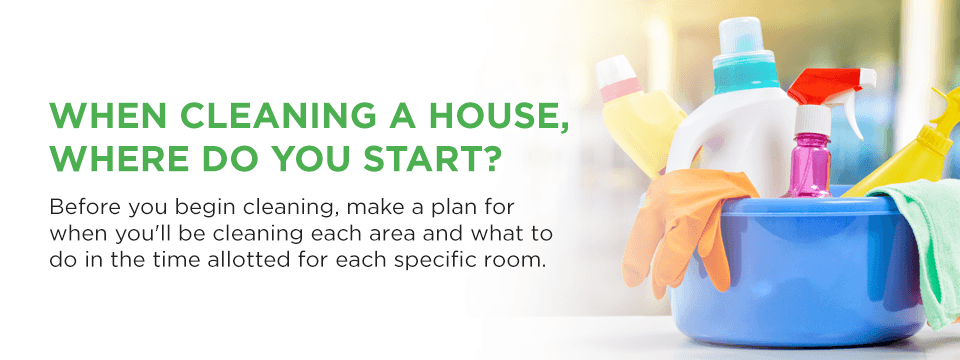
When you begin cleaning your house room by room, you might feel overwhelmed by the amount of space you need to scour and unsure of where to begin. Should you start with the upstairs or the downstairs? What parts of each room will you need to focus on? How long will it take to thoroughly clean your house top to bottom? When you’re taking on a cleaning project of this scale, it can be easy to overthink and feel like you’re out of your depth, but don’t worry — it’s not as hard or as much work as it seems when you break up your cleaning into different areas and different days. One of the best house cleaning secrets is scheduling — to keep your sanity intact, keep you from overworking yourself and make sure you’re doing the most thorough job in every room, it’s important to break up your rooms and tasks into a specific cleaning schedule separated into days or weeks.
Before you begin cleaning, make a plan for when you’ll be cleaning each area and what to do in the time allotted for each specific room. You might want to get your deep cleaning done as quickly as possible, but breaking up your tasks into manageable chunks will ensure you have the right amount of energy and attention for each room and give you the motivation to keep going without burning out. You’ll be checking off areas and spacing out the work according to your schedule.
If you’re hoping to knock out your home cleaning in a week, don’t just roll up your sleeves and try to get as far as you can the day you begin. Instead, assign one room for each day of the week, make a list of the specific tasks you need to tackle in each room and focus only on the current day’s cleaning when each day comes. Even if you can’t spend the entire day cleaning, set aside a little time in the evenings, or when you have a break — remember, you’re going at your pace, and every little bit counts. If you don’t have a ton of time to devote to cleaning and you can’t work on your house every weekday, that’s OK, too — schedule your chores on the weekends, maybe at a pace of one room per day. Whether your deep cleaning takes a week or a month, it will comfort you and keep you moving forward when you have the security of a cleaning schedule to pace yourself with.
Before You Begin
Before you dive into your deep cleaning, you need to make sure you’ve prepared yourself for the job — which means you’re not only mentally equipped with your cleaning game plan, but physically ready to get down and dirty. Rolling up your sleeves and delving into the nitty-gritty cleaning of each room won’t be possible if you’re working around a ton of clutter on your dressers, floors and countertops, so you need to start your deep clean with an initial declutter. Go around your house, working through each room carefully, and pick up any toys, books, paper piles and pet toys. Organize your desks, dressers and countertops, and put away loose items in drawers or cabinets. Make sure your floors, surfaces and windowsills are clear to make room for a thorough scouring and make your job easier when it’s time to vacuum, dust and scrub.
Not only will decluttering before you clean help you clean your house quickly and properly, but it will make you feel more organized and more confident in your living space and your cleaning efforts. A clean home is a clean mind, after all, and once you’ve made everything neat and tidy, you’ll want it to be spic, span and squeaky-clean to match.
New or Old Home Full Cleaning: What You’ll Need
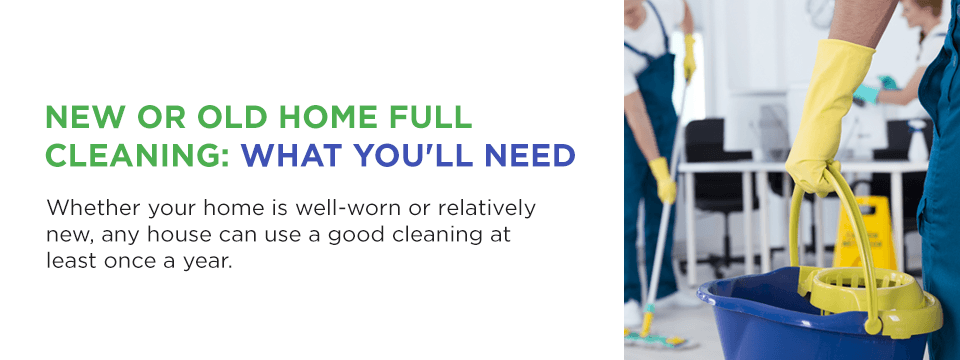
Whether your home is well-worn or relatively new, any house can use a good cleaning at least once a year. Because you want to get right down to it when it comes time to clean and not lose your flow in the middle if you end up needing materials you don’t have, it’s a good idea to make sure you’re stocked up on deep home cleaning supplies before you begin. Don’t worry about the deep cleaning house cost — you’re likely to have most of the materials you’ll need around the house already, and if not, they’re simple, affordable and only a trip to the grocery store away. Here’s your house cleaning materials checklist:
- Baking soda — When it comes to scrubbing those hard-to-tackle stains on fabric or floors and getting off that caked-in grime from your surfaces, baking soda does the trick beautifully. You probably already have this in your pantry, and when you combine it with vinegar, you won’t need to invest in a bunch of pricey cleaners — that’s one of our favorite deep cleaning house hacks.
- Bleach — When you’re cleaning your bathrooms or kitchen, you might want to make sure your sinks and bathtub are spotless and free of any accumulated bacteria, so it’s always a good idea to have powdered bleach on hand.
- Broom — We know, you have a vacuum cleaner — but this is a thorough cleaning, and to make sure you get every speck of dust in every corner and hard-to-reach space, you’ll need a broom, too. Use it to reach into corners, under tables, behind appliances and even to sweep out cobwebs or dust from ceiling corners. You don’t need anything especially fancy — just something to sweep!
- Cleaning caddy — When you’re carrying your cleaning materials from room to room to scour your house from bottom to top, it might become a little bothersome to lug each item up and down the stairs or to different areas of the house, one by one. That’s why it’s always a good idea to carry a cleaning caddy or a portable container you can use to store and transport all your cleaning essentials. You can purchase a cleaning caddy at the store, or use a basket or large Tupperware container — whatever works! Keep in mind, a handle is handy for something you’ll be using to transport materials.
- Dish soap — It might sound simplistic, but scrubbing your countertops and other non-wooden surfaces can be as easy as diving in with some dish soap! Your regular brand should work just fine.
- Duster — Breathing in the clean, fresh scent of your squeaky-clean home is one of the best parts of a deep house cleaning, so make sure you remember your duster. It will help you eliminate every speck of dust from walls, ceilings, corners, baseboards and wherever else it hides.
- Lint roller — Your furniture and fabrics can collect dust, lint and hair just like your clothing — even when you vacuum it regularly. Keep a few lint rollers on hand for making sure your couches and curtains are as clean as possible.
- Mineral oil — Natural, fresh-smelling and environmentally friendly, mineral oil can serve a variety of uses when cleaning — including toilet bowl cleaner, wood treatment, furniture polish and air freshening. If you’re looking for a versatile cleaning material you don’t need too much of, mineral oil can go a long way — and save you from having to buy various area-specific cleaners. You can also just rub a little on your surfaces and wipe them down after you’ve cleaned them to give your space a clean, fresh smell.
- Mop — You want those hard floors to shine more than they do when you vacuum — plus, you want to erase all the caked-on dirt and grime that’s accumulated during the year. Mopping may sound old-fashioned, but it’s the best way to keep your laminate, tile and other hard floor surfaces clean, so make sure you make a mopping plan.
- Multi-purpose cleaner — You’re cleaning every room in the house — that’s a job that calls for multi-purpose cleaner. Having this on hand will cover you for any area of your home.
- Plastic gloves — When you’re using bleach or other strong cleaning materials, you’ll need plastic gloves to protect your hands and keep them from drying out.
- Paper towels or rags — When you’re wiping down your surfaces and furniture, you’ll need materials like paper towels or reusable rags to help you with the job.
- Sponges — Sponges are a reusable, helpful tool for cleaning your bathrooms and kitchen.
- Stiff-bristled brush — A handheld brush with stiff bristles will help you scrub those caked-on counters and surfaces with ease to get everything squeaky-clean.
- Vacuum cleaner with extensions — You want all your floors to be free of dust, debris, hair and whatever else accumulates, so make sure you have a high-quality vacuum cleaner with extension accessories to cover hard-to-reach areas.
- Vinegar — Mix this with your baking soda, and you’ll have a powerful cleaning solution for almost any surface. White vinegar works best.
- Window and glass cleaner — When you’re doing your deep house cleaning, don’t forget your windows and mirrors! Invest in a modest bottle of Windex or another glass cleaner.
- Wood cleaner — Deep cleaning isn’t just dusting and vacuuming — to keep your wooden furniture and surfaces shiny and well-treated, make sure you have some wood cleaner to nourish your wood. You can even choose a product with a rich scent like orange to keep your rooms smelling fresh long after you treat your wood furniture.
Kitchen Cleaning Tips and Methods
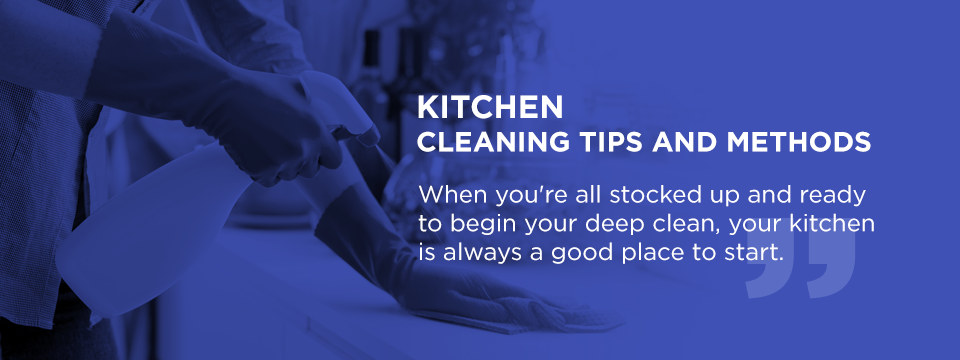
When you’re all stocked up and ready to begin your deep clean, your kitchen is always a good place to start. As one of the central areas of the home, it not only sees a lot of traffic but gets a lot of use — and is probably the most in need of a good scouring. Plus, when your kitchen is well-cleaned, it will give you the motivation to continue with easier areas. Here’s a checklist of cleaning hacks for your kitchen:
- Clear your counters and scrub them down — Remove all your decor, countertop appliances and kitchen items from your countertops, spray them with cleaner and wipe them down. This step removes all crumbs, dust and grime and sanitizes your surfaces.
- Wipe down cabinets — Use your wood cleaner or all-purpose cleaner to wipe down, clean and treat your wood cabinets or cabinets of another material.
- Vacuum the floors and refrigerator coils — Vacuum your entire kitchen floor, making sure to get behind and beneath appliances like the fridge and oven, under tables and in corners. Use your extension accessories to vacuum the refrigerator coils, as well.
- Mop the floors — After you’ve vacuumed, mop your floors with the appropriate solution to get them clean and shining.
- Clean your fridge and freezer — Remove your groceries from your refrigerator and freezer, clean out the insides with a non-toxic cleaner and re-organize your food for a fresher fridge and mind.
- Scrub your stove and clean your oven — Most ovens have a self-cleaning setting, which you should run before wiping it out. Scrub down and sanitize your stove range, as well.
- Clean out the microwave — Take out the spinning plate and wipe down the microwave with a non-toxic cleaner.
- Disinfect your sink — Remove any dishes or sponges from your sink, spray with disinfectant and wipe down, then rinse with water.
- Organize your pantry and cabinets — Go through your cabinets and pantry, organizing your food and dishes. You’ll know where to find everything and feel refreshed by your new organized system.
- Toss old sponges and washcloths — Nothing builds up bacteria like the wet sponges and washcloths you use to clean your dishes and counter, so make sure to throw away any you’ve had for a while and replace them with fresh, new sponges or cloths instead.
- Wipe down windows — Use your glass cleaner to wipe down the insides and outsides of your windows.
Living Room Cleaning Tips and Methods
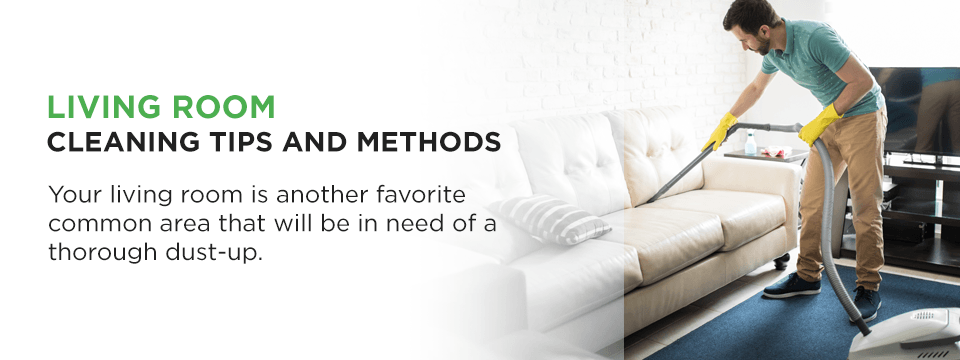
As the area where your family likely spends the most time watching TV and relaxing, your living room is another favorite common area that will be in need of a thorough dust-up. Here’s your checklist for scouring your living room or family room:
- Remove couch and chair cushions and vacuum beneath them — Strip your couches and chairs of their pillows and cushions and vacuum thoroughly inside the couches with your extension accessories, making sure to get in the crevices.
- Move furniture, vacuum and shampoo carpets — Vacuum your floors, being sure to move your couches and furniture to uncover the areas underneath them, and shampoo the entire carpet when you’ve finished.
- Dust furniture and decor — With your duster, thoroughly clean your furniture and decor to remove dust and dirt buildup.
- Polish your wooden furniture — Use your wood cleaner to treat and polish your wooden furniture until it shines.
- Wipe down baseboards, light fixtures and fans — Don’t forget the little things! Use a duster or broom to remove cobwebs and dust from corners, baseboards and high places, then wipe down your baseboards and light fixtures with a clean cloth.
- Clean electronics — If your television or music systems are looking dusty or streaky, gently wipe them down with an electronics wipe to give the room an even fresher feel.
- Wipe down windows — Finish off your living room deep cleaning by wiping down the windows with your glass cleaner. Sparkling!
Dining Room Cleaning Tips and Methods
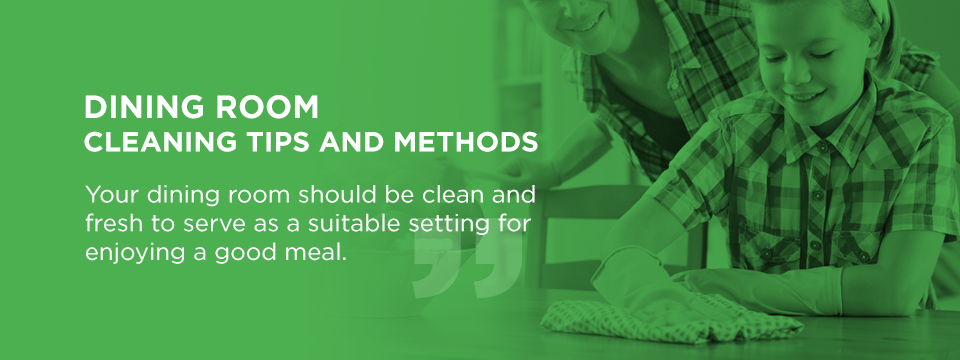
Even if you only use it for special occasions like Thanksgiving or extended family dinners, your dining room should be clean and fresh to serve as a suitable setting for enjoying a good meal. Here’s what you need to do to clean your dining room thoroughly:
- Dust walls, ceiling, baseboards and furniture — First, use your duster to remove the dust buildup from your walls, baseboards, tabletop, furniture and any light fixtures in the room.
- Wipe down or treat furniture and table — After you’ve dusted, wipe down your tables and furniture with the appropriate kind of cleaner — whether that’s wood cleaner or multi-surface cleaner for other materials.
- Organize hutches and clean dishes — If you have a hutch to keep your fine china or dishes for special occasions, now is the time to freshen it. Gently remove your dishes and wash them by hand, dust your shelves and wipe down the inside of the hutch, then replace its contents.
- Wipe down windows — Use your glass cleaner to make your windows shine inside and out.
- Vacuum or mop floors — Vacuum carpets or mop your floors if they’re a hard surface.
Bedroom Cleaning Tips and Methods
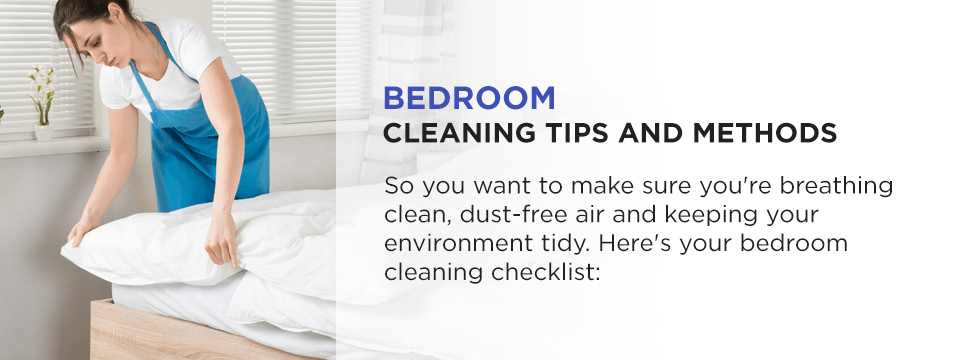
You spend every night and a good portion of your day in your bedroom — whether you’re sleeping, changing or catching some relaxation time — so you want to make sure you’re breathing clean, dust-free air and keeping your environment tidy. Here’s your bedroom cleaning checklist:
- Wash the bedding, sheets and curtains — Start by stripping your bed of its sheets, covers, pillowcases and mattress covers and throwing everything in the wash to freshen it up. If you have curtains in your bedroom, wash those, too.
- Flip your mattress — To freshen your mattress and keep your bed from settling too much to your body’s indent, flip your mattress over while you have your bed stripped and pat it down a bit.
- Dust windowsills, furniture, walls and ceiling fixtures — Using your duster, wipe off your furniture surfaces, walls, baseboards, windowsills and ceiling fixtures to get rid of the extra dust that’s been sitting in your room.
- Vacuum or mop floors — Thoroughly vacuum your floors — including the space beneath your bed and behind your furniture — and follow up with a mopping if your bedroom has hard floors.
- Wipe down drawer interiors and shelves — Dust and wipe down your shelves, and — if you’re feeling extra thorough — remove the contents of your dressers and desks to dust and clean their drawers, as well.
- Clean out and organize closets and drawers — Go through your closet, your dressers and any other possessions in your room, tossing or giving away what you no longer use and organizing the contents you keep. Believe us, it’s liberating.
- Treat wooden furniture — Use your wood cleaner to polish any wooden furniture, including your bed frame and headboard.
- Wipe down windows — Finish off your bedroom cleaning with a shine by wiping down your windows with your glass cleaner.
Bathroom Cleaning Tips and Methods
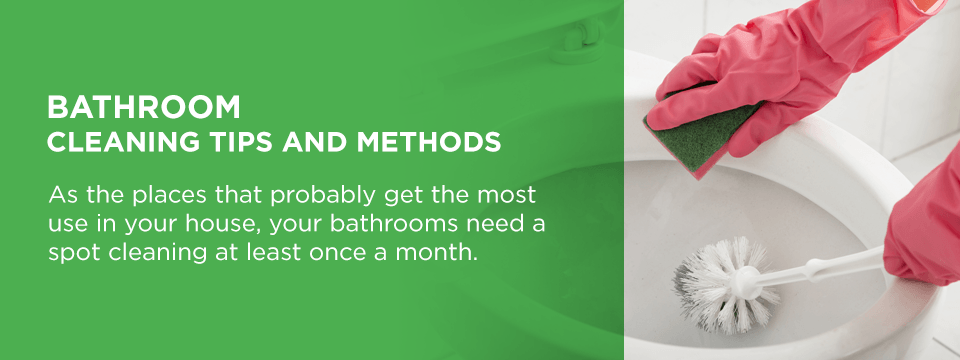
As the places that probably get the most use in your house, your bathrooms need a spot cleaning at least once a month — but when you dive in for a deep clean, here are some bathroom cleaning hacks for a sparkling fresh space:
- Scrub down sinks, showers and bathtubs — Using your bleach, bathroom cleaner or multi-purpose cleaner, scour your sinks, tubs and shower area to remove all traces of mold or dirt accumulation with a scrub brush or cloth.
- Clean and disinfect toilet — Use your toilet cleaner, bleach or multipurpose cleaner to scrub and sanitize your toilet bowl inside and out. Be sure to wipe down the floor around the toilet when you’ve finished to prevent moisture buildup.
- Wipe down counters, mirrors and windows — Remove everything from your countertops and scrub them down using a grout mixture of baking soda and vinegar. Your stiff-bristled brush will help you get out all the grime. Wipe away residual cleaner with a paper towel or cloth and sanitize with multi-purpose cleaner. Next, use your glass cleaner to wipe down your mirrors and windows. If you have a glass shower door, scrub it down with bleach, then polish it with glass cleaner.
- Dust and wipe down walls and light fixtures — Use your duster to clean your walls, baseboards, corners and light fixtures.
- Clean and organize cabinets — Organize the contents of your bathroom cabinets, then wipe down the outsides with wood cleaner or a multi-purpose cleaner for non-wood materials.
- Wash shower curtains, towels and bathroom rugs — Strip your bathroom of its curtains, shower curtains, towels, hand towels and rugs. Toss them all in the washer and replace when clean.
- Disinfect doorknobs and handles — Use your multi-purpose cleaner or a sanitizer to disinfect doorknobs, cabinet handles, sink handles and toilet handles, which get a lot of use.
- Vacuum and treat bathroom floor — Thoroughly vacuum your bathroom floor and mop to remove dirt buildup. If your floor is hardwood, use a wood cleaner to polish and treat it.
Basement Cleaning Tips and Methods
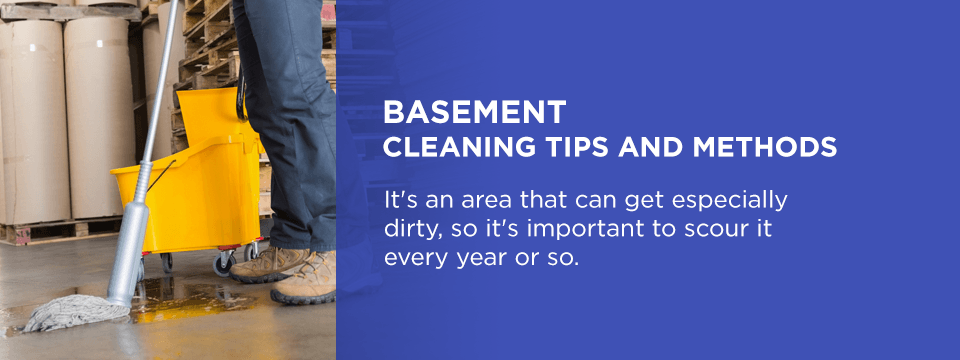
You might not be thinking of your basement when you dive in for a deep house cleaning, but it’s an area that can get especially dirty — so it’s important to scour it every year or so. If you don’t have a basement, this advice will apply equally well to your laundry room. Here are some good housekeeping tips:
- Vacuum floors — Dust and lint are especially sure to accumulate where you do your laundry, and bugs might find their way in as well, so perform a thorough vacuuming of your floors.
- Dust corners, ceilings and light fixtures — Clear out the cobwebs and dust from your corners, light fixtures and ceiling area with your duster and broom.
- Wipe down and sanitize laundry machines — Use your multi-purpose cleaner to wipe down your washer and dryer until they shine.
- Clean out dryer sheets and vents — This step is something you should regularly do to avoid fire hazards, but be sure to clear out lint and dryer sheets from your dryer and make sure your dryer vents are clear.
- Throw away old supplies and organize — If you have old detergent bottles or dryer sheets sitting around, toss them in the trash and try to organize whatever supplies or storage you keep in your basement.
Cleaning Doesn’t Stop: Upkeep Services
When you’ve finished your deep house cleaning, look around your sparkling, spotless home and take a deep breath — doesn’t that feel fresh? Whether it takes a week or a month, you should be proud of the thorough cleaning you’ve performed, and even prouder of your beautiful home. As amazing as a deep house cleaning feels, however, keeping up with your home takes more than a once-a-year scouring. We know how busy life can be — and how spot-cleaning and maintenance can pile up when you’re attending to more important priorities. That’s why we’re here to help.
Offering you personalized, attentive and regular service from caring people who live and work in the Baltimore area just like you, Thai Cleaning Service is a local cleaning company that helps you keep up with all those little cleaning tasks to make sure your house stays in tip-top shape all year. Whether you need help decluttering, keeping up with chores like dishes, trash and laundry, staying on top of regular bathroom cleanings or dusting and vacuuming, our maid service does it all — and we offer you personal, friendly attention you can trust by assigning the same person to handle all your scheduled cleanings. Thai Cleaning Service doesn’t require a contract or commitment — we’re just here to make your life easier and your home cleaner, so you can focus on what’s most important.
We have all the house cleaning secrets you need to feel confident in the state of your home. Contact Thai Cleaning Service today for more information!
